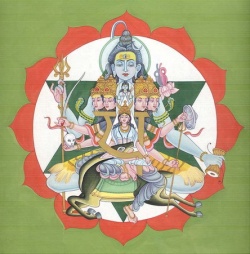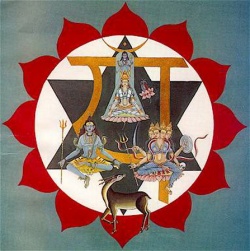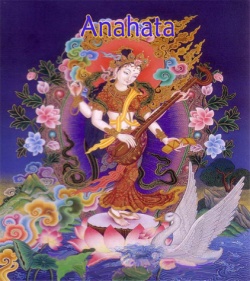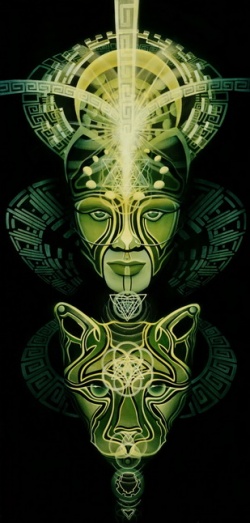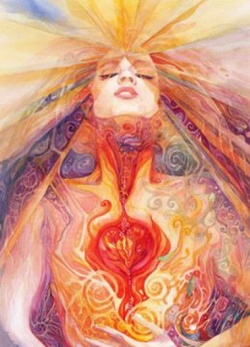Difference between revisions of "Anahata"
| Line 7: | Line 7: | ||
Location | Location | ||
| − | The [[Anahata chakra]] is positioned in the [[central channel]] behind the spine at the [[heart]] region, with its kshetram or [[superficial]] activation site actually in the [[heart]] region between the two breasts. | + | The [[Anahata chakra]] is positioned in the [[central channel]] behind the spine at the [[heart]] region, with its [[kshetram]] or [[superficial]] activation site actually in the [[heart]] region between the two breasts. |
[[Appearance]] | [[Appearance]] | ||
| − | [[Anahata]] is represented by a smoke grey [[lotus flower]], with 12 {{Wiki|vermilion}} petals. Inside of it is a smoke-coloured region that is made from the intersection of 2 triangles, creating a shatkona. The Shatkona is a [[symbol]] used in [[Hindu]] [[yantra]] that represents the union of both the {{Wiki|masculine}} and {{Wiki|feminine}} [[form]]. More specifically it is supposed to represent [[Purusha]] (the [[supreme being]]), and {{Wiki|Prakriti}} (mother [[nature]], or causal matter). Often this is represented as [[Shiva]] - [[Shakti]]. The [[deity]] of this region is [[Vayu]], who is smoke coloured, four-armed, holding a [[kusha]] and riding upon an {{Wiki|antelope}}, the [[animal]] of this [[chakra]]. | + | [[Anahata]] is represented by a smoke grey [[lotus flower]], with 12 {{Wiki|vermilion}} petals. Inside of it is a smoke-coloured region that is made from the intersection of 2 triangles, creating a shatkona. The Shatkona is a [[symbol]] used in [[Hindu]] [[yantra]] that represents the union of both the {{Wiki|masculine}} and {{Wiki|feminine}} [[form]]. More specifically it is supposed to represent [[Purusha]] (the [[supreme being]]), and {{Wiki|Prakriti}} (mother [[nature]], or causal {{Wiki|matter}}). Often this is represented as [[Shiva]] - [[Shakti]]. The [[deity]] of this region is [[Vayu]], who is smoke coloured, four-armed, holding a [[kusha]] and riding upon an {{Wiki|antelope}}, the [[animal]] of this [[chakra]]. |
[[File:Anahata Chakra0.jpg|thumb|250px|]] | [[File:Anahata Chakra0.jpg|thumb|250px|]] | ||
Seed [[mantra]] | Seed [[mantra]] | ||
| − | The [[seed syllable]] is the [[mantra]] 'Yam', dark-grey in {{Wiki|colour}}. Within the [[bindu]] or dot above the {{Wiki|syllable}} resides the [[deity]] [[Isha]] ([[Lord]] in an all pervading [[form]]). [[Isha]] is either shining white or blue in {{Wiki|color}}, has either 1 or 5 faces with 3 [[eyes]] on each face; has 2, 4 or 10 arms; is clad in a [[tiger skin]], holds a [[trident]] and a [[drum]] and/or is making gestures of granting boons and dispelling {{Wiki|fear}}. His [[shakti]] is Kakini, who is shining yellow or rose in {{Wiki|colour}}. She has a number of variations, having either 1, 3 or 6 faces, 2 or 4 arms, and holding a variety of implements, occasionally a sword, shield, skull and [[trident]]. She is seated on a [[red lotus]]. | + | The [[seed syllable]] is the [[mantra]] '[[Yam]]', dark-grey in {{Wiki|colour}}. Within the [[bindu]] or dot above the {{Wiki|syllable}} resides the [[deity]] [[Isha]] ([[Lord]] in an all pervading [[form]]). [[Isha]] is either shining white or blue in {{Wiki|color}}, has either 1 or 5 faces with 3 [[eyes]] on each face; has 2, 4 or 10 arms; is clad in a [[tiger skin]], holds a [[trident]] and a [[drum]] and/or is making gestures of granting boons and dispelling {{Wiki|fear}}. His [[shakti]] is [[Kakini]], who is shining [[yellow]] or rose in {{Wiki|colour}}. She has a number of variations, having either 1, 3 or 6 faces, 2 or 4 arms, and holding a variety of implements, occasionally a sword, shield, [[skull]] and [[trident]]. She is seated on a [[red lotus]]. |
Petals | Petals | ||
| Line 22: | Line 22: | ||
[[Anahata]] is considered the seat of the [[Jivatman]], and [[Para Shakti]]. In the [[Upanishads]], this is described as being like a tiny flame that resided inside the [[heart]]. [[Anahata]] is so called because it is in this place that [[sages]] hear that [[sound]] ([[Anahata]] – [[Shabda]]) which comes without the striking of any two things together.”[2] It is associated with the [[element]] of [[air]], the [[sense]] of {{Wiki|touch}}, and with [[actions]] of the hands. | [[Anahata]] is considered the seat of the [[Jivatman]], and [[Para Shakti]]. In the [[Upanishads]], this is described as being like a tiny flame that resided inside the [[heart]]. [[Anahata]] is so called because it is in this place that [[sages]] hear that [[sound]] ([[Anahata]] – [[Shabda]]) which comes without the striking of any two things together.”[2] It is associated with the [[element]] of [[air]], the [[sense]] of {{Wiki|touch}}, and with [[actions]] of the hands. | ||
[[File:Gaia-Tree.jpg|thumb|250px|]] | [[File:Gaia-Tree.jpg|thumb|250px|]] | ||
| − | [[Anahata]] is associated with the ability to make decisions outside of the [[realm]] of [[karma]]. In [[Manipura]] and below, man is bound by the laws of [[karma]], and the [[fate]] he has in store for him. In [[Anahata]], one is making decisions, 'following your [[heart]]', based upon one's higher [[self]], and not from the unfulfilled [[emotions]] and [[desires]] of lower [[nature]]. | + | [[Anahata]] is associated with the ability to make decisions outside of the [[realm]] of [[karma]]. In [[Manipura]] and below, man is [[bound]] by the laws of [[karma]], and the [[fate]] he has in store for him. In [[Anahata]], one is making decisions, 'following your [[heart]]', based upon one's higher [[self]], and not from the unfulfilled [[emotions]] and [[desires]] of lower [[nature]]. |
It is also associated with [[love]] and [[compassion]], [[charity]] to others, and [[forms]] of [[psychic]] [[healing]]. | It is also associated with [[love]] and [[compassion]], [[charity]] to others, and [[forms]] of [[psychic]] [[healing]]. | ||
| Line 30: | Line 30: | ||
[[Hrit chakra]], just below [[Anahata]], is the seat of the wish-fulfilling [[tree]]. | [[Hrit chakra]], just below [[Anahata]], is the seat of the wish-fulfilling [[tree]]. | ||
| − | Immediately below [[Anahata]] at the {{Wiki|solar}} plexus, or sometimes located slightly to the left-hand side of the [[body]], is a minor [[chakra]] known as [[Hrit]], or [[Hridaya]] ([[heart]]), with eight petals. It contains three consecutive regions, a {{Wiki|vermilion}} {{Wiki|sun}} region, within which is a white [[moon]] region, within which is a deep-red [[fire]] region, and within this is the red wish-fulfilling [[tree]], [[kalpa taru]], which [[symbolizes]] the ability to [[manifest]] whatever one wishes to happen in the [[world]]. | + | Immediately below [[Anahata]] at the {{Wiki|solar}} plexus, or sometimes located slightly to the left-hand side of the [[body]], is a minor [[chakra]] known as [[Hrit]], or [[Hridaya]] ([[heart]]), with [[eight petals]]. It contains three consecutive regions, a {{Wiki|vermilion}} {{Wiki|sun}} region, within which is a white [[moon]] region, within which is a deep-red [[fire]] region, and within this is the [[red]] wish-fulfilling [[tree]], [[kalpa taru]], which [[symbolizes]] the ability to [[manifest]] whatever one wishes to happen in the [[world]]. |
[[Hrit chakra]] is occasionally identified as [[Surya]] ({{Wiki|Sun}}) [[chakra]], which again is situated below the [[heart]], and sometimes slightly to the left. Its role is to absorb [[energy]] from the {{Wiki|sun}}, and to provide heat to the [[body]] and other [[chakras]], in particular to [[Manipura]], to which it provides the [[Agni]] or [[fire element]]. | [[Hrit chakra]] is occasionally identified as [[Surya]] ({{Wiki|Sun}}) [[chakra]], which again is situated below the [[heart]], and sometimes slightly to the left. Its role is to absorb [[energy]] from the {{Wiki|sun}}, and to provide heat to the [[body]] and other [[chakras]], in particular to [[Manipura]], to which it provides the [[Agni]] or [[fire element]]. | ||
| − | Associations with the [[body]] | + | {{Wiki|Associations}} with the [[body]] |
[[File:Anahata Chakra-ges.jpg|thumb|250px|]] | [[File:Anahata Chakra-ges.jpg|thumb|250px|]] | ||
| − | [[Anahata]] is said to be located near the region of the [[heart]]. Because of its association with {{Wiki|touch}}, it is associated with the {{Wiki|skin}}, and because of its association with [[actions]] of the hands, it is associated with the hands. In the endocrine system, [[Anahata]] is supposedly associated with the thymus gland, located in the {{Wiki|chest}}.[citation needed] | + | [[Anahata]] is said to be located near the region of the [[heart]]. Because of its association with {{Wiki|touch}}, it is associated with the {{Wiki|skin}}, and because of its association with [[actions]] of the hands, it is associated with the hands. In the {{Wiki|endocrine system}}, [[Anahata]] is supposedly associated with the [[thymus]] gland, located in the {{Wiki|chest}}.[citation needed] |
Practices | Practices | ||
| − | In [[Kundalini yoga]], [[anahata]] is awoken and balanced through practices including [[asanas]], [[pranayamas]], and the practice of [[ajapa japa]] (the practice of [[japa]] without the [[mental]] [[effort]] normally needed to repeat the [[mantra]].). It is [[purified]] through the process of [[bhakti]] ([[devotion]]). | + | In [[Kundalini yoga]], [[anahata]] is awoken and balanced through practices [[including]] [[asanas]], [[pranayamas]], and the practice of [[ajapa japa]] (the practice of [[japa]] without the [[mental]] [[effort]] normally needed to repeat the [[mantra]].). It is [[purified]] through the process of [[bhakti]] ([[devotion]]). |
Comparisons with other Systems | Comparisons with other Systems | ||
| Line 44: | Line 44: | ||
[[Tibetan Buddhism]] | [[Tibetan Buddhism]] | ||
| − | The [[heart]] [[wheel]] in [[Tibetan Buddhism]] is the location of the [[indestructible]] red and [[white drop]]. At the [[time]] of [[death]], all the [[subtle winds]] of the [[body]] dissolve and enter into this drop, which then leaves the [[body]] into the [[Bardo]], [[intermediate stage]], and then into [[rebirth]]. The [[heart]] [[wheel]] in this model is circular, white, and has 8 petals or channels that reach downwards. These channels divide into 3, the [[mind]] [[wheel]], [[speech]] [[wheel]], and [[body]] [[wheel]], and go to 24 places in the [[body]], after which they divide into 3 again, and then into 1000, producing 72000 [[channels]], known as [[Nadi]] which spread out throughout the whole [[body]]. | + | The [[heart]] [[wheel]] in [[Tibetan Buddhism]] is the location of the [[indestructible]] [[red]] and [[white drop]]. At the [[time]] of [[death]], all the [[subtle winds]] of the [[body]] dissolve and enter into this drop, which then leaves the [[body]] into the [[Bardo]], [[intermediate stage]], and then into [[rebirth]]. The [[heart]] [[wheel]] in this model is circular, white, and has 8 petals or [[channels]] that reach downwards. These [[channels]] divide into 3, the [[mind]] [[wheel]], [[speech]] [[wheel]], and [[body]] [[wheel]], and go to 24 places in the [[body]], after which they divide into 3 again, and then into 1000, producing 72000 [[channels]], known as [[Nadi]] which spread out throughout the whole [[body]]. |
[[File:Anahata Chakra60.jpg|thumb|250px|]] | [[File:Anahata Chakra60.jpg|thumb|250px|]] | ||
The [[heart wheel]] is very important within [[meditation]]. In the [[lower tantras]], the {{Wiki|recitation}} of [[mantra]] is done from the [[heart]]. At first, a [[mantra]] is recited verbally, then [[mentally]], and then inside of the [[heart]] a tiny [[moon]] disc and a flame is [[imagined]], from which the [[sound]] of the [[mantra]] is heard ringing out. In the [[higher tantras]], the [[Anuttarayoga Tantra]] of the [[Sarma schools]] or the [[Inner Tantras]] of the [[Nyingma school]], the [[practitioner]] attempts to dissolve the [[winds]] and drops into the [[central channel]] at the level of the [[heart]] in order to [[experience]] the [[Yoga]] of [[Clear Light]]; this is one of the practices of the 6 [[yogas of Naropa]]. | The [[heart wheel]] is very important within [[meditation]]. In the [[lower tantras]], the {{Wiki|recitation}} of [[mantra]] is done from the [[heart]]. At first, a [[mantra]] is recited verbally, then [[mentally]], and then inside of the [[heart]] a tiny [[moon]] disc and a flame is [[imagined]], from which the [[sound]] of the [[mantra]] is heard ringing out. In the [[higher tantras]], the [[Anuttarayoga Tantra]] of the [[Sarma schools]] or the [[Inner Tantras]] of the [[Nyingma school]], the [[practitioner]] attempts to dissolve the [[winds]] and drops into the [[central channel]] at the level of the [[heart]] in order to [[experience]] the [[Yoga]] of [[Clear Light]]; this is one of the practices of the 6 [[yogas of Naropa]]. | ||
| Line 54: | Line 54: | ||
{{Wiki|Sufism}} | {{Wiki|Sufism}} | ||
| − | The Sufis manage a system of Lataif-e-sitta, that are positioned at various points on the [[body]], and at the level of the [[heart]] there are 3 positioned horizontally. To the left of the {{Wiki|chest}} is the Qalb, or [[heart]], the Ruh, on the right hand side of the {{Wiki|chest}}, and the Sirr, or secret, of the innermost [[heart]], between the two of them.[6] | + | The [[Sufis]] manage a system of [[Lataif-e-sitta]], that are positioned at various points on the [[body]], and at the level of the [[heart]] there are 3 positioned horizontally. To the left of the {{Wiki|chest}} is the Qalb, or [[heart]], the Ruh, on the right hand side of the {{Wiki|chest}}, and the Sirr, or secret, of the innermost [[heart]], between the two of them.[6] |
| − | The Qalb is called the [[heart]] of the [[mystic]], which is caught between the downward pull of the lower nafs, and the upward pull of the [[spirit]] of {{Wiki|Allah}}, and thus it can be blackened by [[sin]]. It may be [[purified]] by {{Wiki|recitation}} of the names of [[God]]. | + | The Qalb is called the [[heart]] of the [[mystic]], which is caught between the downward pull of the lower [[nafs]], and the upward pull of the [[spirit]] of {{Wiki|Allah}}, and thus it can be blackened by [[sin]]. It may be [[purified]] by {{Wiki|recitation}} of the names of [[God]]. |
| − | The Ruh is the centre of the [[spirit]], the [[breath]] of {{Wiki|Allah}}, and when awoken it counteracts the negative pull of the nafs. | + | The Ruh is the centre of the [[spirit]], the [[breath]] of {{Wiki|Allah}}, and when awoken it counteracts the negative pull of the [[nafs]]. |
The Sirr is the secret or innermost [[heart]], called the [[heart]] of the [[heart]], where {{Wiki|Allah}} [[manifests]] his {{Wiki|mystery}} to himself. | The Sirr is the secret or innermost [[heart]], called the [[heart]] of the [[heart]], where {{Wiki|Allah}} [[manifests]] his {{Wiki|mystery}} to himself. | ||
| − | Qigong | + | [[Qigong]] |
| − | In Qigong the middle Dantian is located in this region. This Dantian is one of the three furnaces that [[transform]] [[energy]] in the [[body]]. The middle Dantian transforms the qi [[energy]] into shen, or [[spirit]] [[energy]]. | + | In [[Qigong]] the middle [[Dantian]] is located in this region. This [[Dantian]] is one of the three furnaces that [[transform]] [[energy]] in the [[body]]. The middle [[Dantian]] transforms the qi [[energy]] into shen, or [[spirit]] [[energy]]. |
</poem> | </poem> | ||
{{W}} | {{W}} | ||
[[Category:Anahata]] | [[Category:Anahata]] | ||
Revision as of 05:09, 30 January 2016
Anahata (Sanskrit: अनाहत, Anāhata) is the fourth primary chakra according to the Hindu Yogic,Shakta) and Buddhist Tantric traditions.
In Sanskrit the word anahata means unhurt, unstruck and unbeaten. Anahata Nad refers to the Vedic concept of unstruck sound, the sound of the celestial realm.
Location
The Anahata chakra is positioned in the central channel behind the spine at the heart region, with its kshetram or superficial activation site actually in the heart region between the two breasts.
Appearance
Anahata is represented by a smoke grey lotus flower, with 12 vermilion petals. Inside of it is a smoke-coloured region that is made from the intersection of 2 triangles, creating a shatkona. The Shatkona is a symbol used in Hindu yantra that represents the union of both the masculine and feminine form. More specifically it is supposed to represent Purusha (the supreme being), and Prakriti (mother nature, or causal matter). Often this is represented as Shiva - Shakti. The deity of this region is Vayu, who is smoke coloured, four-armed, holding a kusha and riding upon an antelope, the animal of this chakra.
Seed mantra
The seed syllable is the mantra 'Yam', dark-grey in colour. Within the bindu or dot above the syllable resides the deity Isha (Lord in an all pervading form). Isha is either shining white or blue in color, has either 1 or 5 faces with 3 eyes on each face; has 2, 4 or 10 arms; is clad in a tiger skin, holds a trident and a drum and/or is making gestures of granting boons and dispelling fear. His shakti is Kakini, who is shining yellow or rose in colour. She has a number of variations, having either 1, 3 or 6 faces, 2 or 4 arms, and holding a variety of implements, occasionally a sword, shield, skull and trident. She is seated on a red lotus.
Petals
The twelve petals are vermilion coloured, and upon them are inscribed the syllables kam, kham, gam, gham, ngam, cham, chham, jam, jham, nyam, tam and tham in Sanskrit. They match the vrittis of lust, fraud, indecision, repentance, hope, anxiety, longing, impartiality, arrogance, incompetence, discrimination and defiance.
Function
Anahata is considered the seat of the Jivatman, and Para Shakti. In the Upanishads, this is described as being like a tiny flame that resided inside the heart. Anahata is so called because it is in this place that sages hear that sound (Anahata – Shabda) which comes without the striking of any two things together.”[2] It is associated with the element of air, the sense of touch, and with actions of the hands.
Anahata is associated with the ability to make decisions outside of the realm of karma. In Manipura and below, man is bound by the laws of karma, and the fate he has in store for him. In Anahata, one is making decisions, 'following your heart', based upon one's higher self, and not from the unfulfilled emotions and desires of lower nature.
It is also associated with love and compassion, charity to others, and forms of psychic healing.
Meditation on this chakra is said to bring about the following siddhis, or occult powers; he becomes a lord of speech; he is dearer than the dearest to women; his senses are completely under control; and he can enter at will into another's body.
Hrit/Hridaya/Surya Chakra – the wish-fulfilling tree
Hrit chakra, just below Anahata, is the seat of the wish-fulfilling tree.
Immediately below Anahata at the solar plexus, or sometimes located slightly to the left-hand side of the body, is a minor chakra known as Hrit, or Hridaya (heart), with eight petals. It contains three consecutive regions, a vermilion sun region, within which is a white moon region, within which is a deep-red fire region, and within this is the red wish-fulfilling tree, kalpa taru, which symbolizes the ability to manifest whatever one wishes to happen in the world.
Hrit chakra is occasionally identified as Surya (Sun) chakra, which again is situated below the heart, and sometimes slightly to the left. Its role is to absorb energy from the sun, and to provide heat to the body and other chakras, in particular to Manipura, to which it provides the Agni or fire element.
Associations with the body
Anahata is said to be located near the region of the heart. Because of its association with touch, it is associated with the skin, and because of its association with actions of the hands, it is associated with the hands. In the endocrine system, Anahata is supposedly associated with the thymus gland, located in the chest.[citation needed]
Practices
In Kundalini yoga, anahata is awoken and balanced through practices including asanas, pranayamas, and the practice of ajapa japa (the practice of japa without the mental effort normally needed to repeat the mantra.). It is purified through the process of bhakti (devotion).
Comparisons with other Systems
Tibetan Buddhism
The heart wheel in Tibetan Buddhism is the location of the indestructible red and white drop. At the time of death, all the subtle winds of the body dissolve and enter into this drop, which then leaves the body into the Bardo, intermediate stage, and then into rebirth. The heart wheel in this model is circular, white, and has 8 petals or channels that reach downwards. These channels divide into 3, the mind wheel, speech wheel, and body wheel, and go to 24 places in the body, after which they divide into 3 again, and then into 1000, producing 72000 channels, known as Nadi which spread out throughout the whole body.
The heart wheel is very important within meditation. In the lower tantras, the recitation of mantra is done from the heart. At first, a mantra is recited verbally, then mentally, and then inside of the heart a tiny moon disc and a flame is imagined, from which the sound of the mantra is heard ringing out. In the higher tantras, the Anuttarayoga Tantra of the Sarma schools or the Inner Tantras of the Nyingma school, the practitioner attempts to dissolve the winds and drops into the central channel at the level of the heart in order to experience the Yoga of Clear Light; this is one of the practices of the 6 yogas of Naropa.
In the Tibetan scheme of chakras there is also included a chakra known as the Firem Wheel. Its position is not, however, the same as the Hrit/Surya chakra, but is instead above the heart and below the throat.
Kabbalah
On the kabbalistic tree of life, the central sephirah, Tiphereth, is associated with the heart region.[5] Christian kabbalists in particular associate this sephirah with love, healing and Jesus Christ.
Sufism
The Sufis manage a system of Lataif-e-sitta, that are positioned at various points on the body, and at the level of the heart there are 3 positioned horizontally. To the left of the chest is the Qalb, or heart, the Ruh, on the right hand side of the chest, and the Sirr, or secret, of the innermost heart, between the two of them.[6]
The Qalb is called the heart of the mystic, which is caught between the downward pull of the lower nafs, and the upward pull of the spirit of Allah, and thus it can be blackened by sin. It may be purified by recitation of the names of God.
The Ruh is the centre of the spirit, the breath of Allah, and when awoken it counteracts the negative pull of the nafs.
The Sirr is the secret or innermost heart, called the heart of the heart, where Allah manifests his mystery to himself.
Qigong
In Qigong the middle Dantian is located in this region. This Dantian is one of the three furnaces that transform energy in the body. The middle Dantian transforms the qi energy into shen, or spirit energy.
